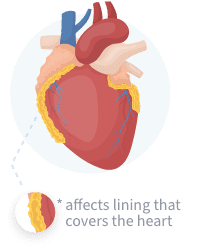Pericardial mesothelioma makes up less than 1% of all mesothelioma cases in the U.S. It occurs when tumors form in the lining of the heart (pericardium). Although the prognosis is generally poor, some patients have extended their pericardial mesothelioma life expectancy with certain treatments.
What Is Pericardial Mesothelioma?

Malignant pericardial mesothelioma is one of the rarest types of mesothelioma, with only about 350 cases having been reported in medical journals.
There are two layers of the pericardium (the sac-like membrane surrounding the heart): an inner layer and an outer layer. Pericardial mesothelioma can develop in either layer.
The specific causes of pericardial mesothelioma are still unclear, but asbestos exposure is likely a contributing factor in at least some cases.
As opposed to other types of mesothelioma, however, most veterans diagnosed with pericardial mesothelioma do not have a known history of asbestos exposure.
Veterans with pericardial mesothelioma may be eligible for free or reduced-cost health care through the U.S. Department of Veterans Affairs (VA). Get a Free Veterans Packet to learn more.
Pericardial Mesothelioma Symptoms
Pericardial mesothelioma causes few to no symptoms as long as it does not spread beyond the heart lining. This is why it is rarely diagnosed in its early stages.
When pericardial mesothelioma symptoms do occur, they most often resemble those seen in heart disease. As a result, people are often diagnosed with some type of heart condition before doctors confirm a pericardial mesothelioma diagnosis.
The telltale signs of pericardial mesothelioma can usually only be observed with visual imaging tests. One common sign is pericardial fluid buildup around the heart. This is often detected with an echocardiogram, X-rays, or a computed tomography (CT) scan of the chest.
With that said, physical pericardial mesothelioma symptoms may include:
- Chest pain
- Dry cough
- Difficulty breathing (dyspnea)
- Exhaustion
- Fever
- Heart palpitations
- New onset of a heart murmur
- Night sweats
- Shortness of breath (with or without activity)
- Weight loss
- Worsening of shortness of breath when lying down
If you have any of these symptoms, you should seek medical attention. They could be signs that you have fluid buildup around your heart.
Causes of Pericardial Mesothelioma
Doctors and researchers have not yet found the exact cause of pericardial mesothelioma.
The exact relationship between asbestos and pericardial mesothelioma is less clear than it is in more common types of mesothelioma.
Theoretically, asbestos fibers could travel from the lungs to the lining around the heart. The asbestos fibers could then embed themselves into the lining of the heart, irritating the tissue. However, it can take several years for asbestos fibers to migrate to the pericardium and turn tissue into cancerous cells.
After pericardial cells mutate and turn into a malignancy (cancer), they quickly divide and form tumors around the heart. The cancer cells thicken the pericardial lining and fluid begins to build up in response to the irritation of the lining. This puts added stress on the heart, leading to heart-related symptoms.
Diagnosis of Pericardial Mesothelioma
Pericardial mesothelioma is a challenging disease to diagnose because of how rare it is and how similar its symptoms are to those found in more common illnesses such as heart disease.


During a pericardial mesothelioma diagnosis, the doctor will ask about the patient's symptoms and perform a physical exam.
Imaging tests, such as an echocardiogram, a magnetic resonance imaging (MRI) scan, a chest X-ray, or a CT scan, may show the thickening of the pericardium. MRIs and CT scans can also reveal fluid around the heart, another symptom of pericardial mesothelioma.
Specialized doctors called thoracic surgeons may then perform a procedure called a pericardiocentesis. This involves inserting a needle into the space between the heart and the pericardium to take a fluid sample. Sometimes cancer cells can be found when looking at this fluid under a microscope.
In some cases, it takes a biopsy (tissue sample) of the affected area to definitively diagnose pericardial mesothelioma.
Another technique uses radioactive dye to find pericardial mesothelioma. An injection of this dye can show evidence of the disease on imaging tests. However, CT scans of the chest are still the most common imaging test.
Only about 10-20% of pericardial mesothelioma cases are diagnosed while the patient is still alive. The rest are found in an autopsy after the patient has already passed away.
Pericardial mesothelioma is often misdiagnosed as:
- Acute heart failure
- Cardiac tamponade
- Coronary artery disease
- Intra-atrial myxoma
- Pericarditis
- Tuberculosis of the pericardium
- Weakness of the heart muscle
One case study published in 2022 reported that a 57-year-old woman with symptoms of chest tightness and panic was diagnosed with tuberculous pericarditis instead of pericardial mesothelioma. The researchers said this is the most common misdiagnosis of the cancer.
If you were diagnosed with any of the above conditions and you suspect a misdiagnosis, you should seek a second opinion from a heart and lung specialist to rule out pericardial mesothelioma.
To make sure you get the answers you need, download our Free Checklist of Questions to Ask Your Doctor ahead of your appointment.
Pericardial Mesothelioma Treatment
Pericardial mesothelioma is difficult to treat because of the cancer's proximity to the heart.
However, there are certain methods that may be used to treat the disease or its symptoms:
- Chemotherapy is often the first line of treatment. Doctors also use chemotherapy to kill tumor cells that weren’t removed by radiation and surgery. Cisplatin is a commonly used chemotherapy treatment for this cancer.
- Radiation therapy can shrink the size of pericardial tumors and relieve symptoms.
- Surgery can remove the visible signs of a tumor. The most common surgery for this mesothelioma is called a pericardiectomy. This involves surgical resection of the heart lining.
- Palliative treatments can also be used to ease symptoms. For example, minor treatments can remove fluid buildup around the heart (pericardial effusion) and reduce pericardial thickening.
- New treatments continue to be studied in clinical trials. For example, immunotherapy has been approved to treat pleural mesothelioma and may also become available to pericardial mesothelioma patients at some point.
Surgery is one of the most effective ways to improve a poor prognosis. According to a 2018 study published in the Annals of Thoracic Study, a 54-year-old woman lived for 4 years after being diagnosed with pericardial mesothelioma and undergoing surgical resection (pericardiectomy).
Sadly, pericardial mesothelioma is so rare that doctors have little evidence of effective treatments to compare.
Researchers wrote about this in a 2017 analysis of pericardial mesothelioma treatments. “Primary pericardial mesothelioma is a rare cancer, for which there is no consensus on treatment,” they said.
This lack of consensus makes it worth considering new and emerging therapies. For example, some mesothelioma patients have outlived their initial prognosis after getting experimental medication as part of a clinical trial.
Still, pericardial mesothelioma cancer has a very low median survival rate. About 50% of people diagnosed with pericardial mesothelioma survive longer than 6 months.
Yet, this also means half of the patients out there may benefit from treatment. Only a mesothelioma specialist can determine the best course of action to potentially improve your pericardial mesothelioma life expectancy.
Learn more about your potential treatment options in our Free Veterans Packet, shipped overnight to your door.
Taking Control of Your Prognosis
Doctors have identified several factors that affect a mesothelioma prognosis, such as age, sex, and how far it has spread (metastasized).
However, treatment is probably one of the most important factors of life expectancy. Although there isn’t a standard of treatment for pericardial mesothelioma, every patient is different, and there are always inspiring stories of survivors who've defied the odds.
Contact us today or call our Patient Advocates at (877) 450-8973 to get help finding treatment for pericardial mesothelioma.



